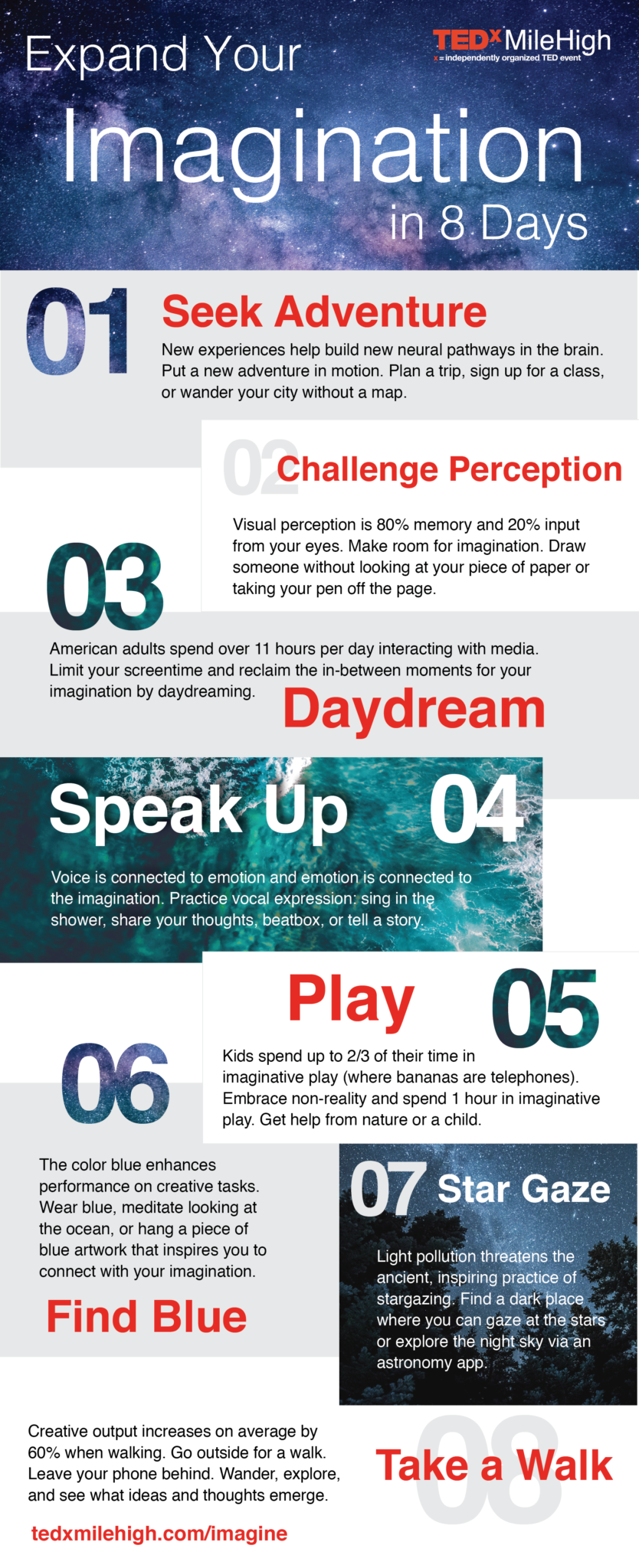Imagination is the foundation of creativity and innovation. It is a state of being that creatives, artists, and entrepreneurs aspire to immerse themselves in. It is a way of seeing the world with awe and wonder. We’ve explored what imagination is and where it comes from. Expand your imagination in 8 days with the TEDxMileHigh Imagination Challenge.
Download the 8-Day Imagination Challenge PDF
Why Expand Your Imagination?
The need to expand your imagination may come from a deep longing to access your creative inner self or inner child. If so, enough said. However, if you don’t feel this draw, there are many reasons you may want to expand your imagination. Because who wouldn’t want to enhance problem-solving skills and brain activity?
Your Brain on Imagination
Put simply, imagination increases neural activity because your mind is mapping unchartered territory. Recollection and memory require less neural activity because your brain becomes more adept at processing information that is familiar. But imagination requires new neural connections because the “brain can’t rely on connections that have been shaped by past experience.”
Creativity and imagination also help with memory and cognition over time. A 2015 Neurology study covered by CNN states that “people who engaged in artistic activities… were 73% less likely to have memory and thinking problems, such as mild cognitive impairment, that lead to dementia.” There are many reasons why you should expand your imagination—creative expression, improved cognition, and improved presence.
How to Expand Your Imagination
Let’s map out the path to imaginative play. Imagination isn’t experienced just by children, but cultivating your imagination as an adult takes personal investment and practice.
Download the 8-Day Imagination Challenge PDF
Here’s how you can expand your imagination with one exercise a day:
1. Seek Adventure
Seeking new experiences is an exercise for your brain and your imagination. According to Fast Company’s The Neuroscience of Imagination, the “surest way to provoke the imagination is to seek out environments you have no experience with.” Experiencing or learning new things requires your mind to think (and neurons to connect) in new ways. It provides new perspectives and supple ground for ideation and creativity.
Challenge
Put a new adventure in motion. Plan a trip or travel to a new city, state or country. Take a drawing, writing, or woodworking class. Sign up for an online class, teach yourself how to juggle on YouTube, or try a new recipe (if you aren’t an avid cook already). Wander your city (or any other city) without Google Maps.
2. Challenge Your Perception
Imagination and creativity are often linked to the exploration of sensory experience: we can find new ideas by exploring our non-dominant senses. What happens when we question our dominant sense? Most people believe that vision is their dominant sense. However, in the essay Perception of Vision, this artist questioned the traditional understanding of vision and found that:
“When the brain processes vision, the vast majority of information is not coming from the eyes, but from memory. In fact, it is now estimated that visual perception is 80% memory and 20% input through the eyes. In other words, sensory information is not transmitted to the brain; it comes from it.” – Jennifer Bornstein
Challenge
How much of what you “see” is pulled from your memory? From your imagination? Through learning the limits of reality via your dominant sense, you may uncover room for imagination in all your senses. Try these exercises:
- Glance out your window for 10 seconds then turn away, close your eyes, and jot down on a piece of paper every detail you can remember. When you are done, look back outside. Excepting small changes, how accurate is your visual image from memory? Did you miss anything? Did you add anything that wasn’t there?
- Draw someone or something nearby without 1) looking at your piece of paper and 2) without taking your pen off the page. Try this a few times (don’t peek until you are done!)
3. Daydream
According to a 2018 Nielsen Total Audience Report, “American adults spend over 11 hours per day listening to, watching, reading or generally interacting with media.” All this time of fragmented and curated mental engagement leaves little room for daydreaming and imagination. This 2015 essay by Leon Wieseltier in the New York Times helps clarify how and why we always feel disrupted:
“As the frequency of expression grows, the force of expression diminishes: Digital expectations of alacrity and terseness confer the highest prestige upon the twittering cacophony of one-liners and promotional announcements.” – Leon Wieseltier
What exactly are we absorbing and what are we truly getting in return? Why do we always feel so busy? What was left to wonder about and do we even have time to wonder? Do you feel robbed of the seconds in a day in which you had spent imagining, prior to being so “connected”? All those quiet moments, whether waiting in line at the post office, watching pasta boil, or eating your lunch on a bench outside, have evaporated now that are all so connected. The moments we used to spend integrating information or just letting an idea simmer are gone.
We have a habit of consumption, rather than creation. Yet, imagination walks hand-in-hand with creativity.
Challenge
Notice all the in-between moments that are occupied by your connection to technology and the consumption of media. Untangle yourself from this need and reclaim those little moments for your imagination. Put your phone down, put your computer away, and engage in life (stare into space for a bit, drink a coffee or tea by yourself, people watch when you’re in line next).
4. Speak Up
Imagination often involves daydreaming, but it can also involve expression and creation. To cultivate imagination, move beyond self-doubt and self-judgment and just experiencing the act of expression. A wonderful way to try this is through vocal expression. Imagination is closely linked to language and voice, which are, in turn, connected to emotion. There is evidence that imagination may have preceded language, and language, through speech or music, is connected to emotion or our desire to connect and empathize. So, using your voice may help you tune into emotion, and thus, your imagination.
Challenge
Exercise your voice. Vocal expression exercises may include singing in the shower, sharing your ideas in a meeting, or telling someone close to you how you feel. If you’re feeling ambitious, you can even try the herding practice of kulning or beatboxing!
5. Play
Imagination is a natural state for children: kids spend up to two-thirds of their time in imaginative play. Imaginative play is play in non-reality: it requires seeing things not as they are, but as they could be on any planet or in any galaxy. Think using a banana as a phone, a cardboard box as a rocket, or a stick like a fishing pole for space creatures. Dream of talking trees or riding on the wings of a hawk (or better yet, being a hawk yourself). This kind of play sometimes appears to accompany a loss of self-control and rational thinking.
“Anybody with artistic ambitions is always trying to reconnect with the way they saw things as a child.” – Tim Burton
Challenge
Spend an hour in imaginative play. Give yourself a window to safely relinquish these aspects of adult life and embrace non-reality. Recruit friends or family to join you or even ask a child if you can join them in their imaginative play (and learn from a master!). If you need a little help with imaginative play, here are some suggestions:
- Start in nature and let yourself imagine anything wild that comes to mind
- Connect with your inner child through meditation or journaling and revisit some of your own earliest imaginations
- Embark on new imaginative journeys through novels in the genres of speculative fiction and magical realism
6. Find and Create a Blue Environment
Consider your surroundings for a moment. Does your space encourage or inhibit creativity and imagination? What states induce creativity? A study from the University of British Colombia found that the color “blue enhances performance on a creative task.” Blue may be associated with openness, calm, and peacefulness.
Challenge
Find 1-2 ways that you can encourage imagination in your environment. Perhaps you can wear blue or hang a piece of blue artwork that inspires you to connect with your imagination. This can also be as simple as playing the right music or adjusting the ambiance of a room.
7. Star Gaze
Stargazing is an ancient practice that inspired many thinkers, creatives, and dreamers. Our ancestors probably spent many of their nights, before bed, gazing up at the stars. With the advent of electricity and light pollution at night, most of us don’t have the chance to wonder at the stars. Yet, this kind of wondering is an important, intergalactic wondering. The Dark Sky Project writes:
“Experiencing the night sky provides perspective, inspiration, and leads us to reflect on our humanity and place in the universe. The history of scientific discovery and even human curiosity itself is indebted to the natural night sky.” – Dark Sky Project
Challenge
Try to get out of town and find a place where you can see the stars. Check out the Dark Sky Project for travel suggestions. If this isn’t an option, find your local planetarium, like the Fiske Planetarium in Boulder. Or, download an astronomy app, like SkySafari, for inspiration. And, If you prefer clouds, you can gaze at those, too.
8. Take a Walk
Walking invokes a creative, imaginative state. A 2014 Stanford study found that “creative output increased by an average of 60% when walking.” Many artists, writers, inventors, and thinkers were onto this long before we had scientific studies to prove it. Explore a few ruminations on the benefits of walking from Rebecca Solnit, Henry David Thoreau, and Kenneth Grahame.
“The man who has no imagination has no wings.” – Muhammed Ali
Challenge
Get up and go outside for a walk. Leave your phone behind. Meander, wander, explore, and see what new ideas and thoughts emerge. (If walking doesn’t resonate with you, try movement meditation, yoga, or dance.)

Share Your Imagination
Now that you’ve learned how to expand your imagination, continue the journey but sharing your imagination skills with the people around and the world at large. With your expansive voice and imaginative playfulness, you can help encourage a more imaginative world.
Actually, you can help to imagine a new world altogether! With the challenges humanity faces in the decades to come, we need all the imagination, creativity, and innovation we can collectively conjure. Find yourself in the company of other dreamers and doers at the upcoming TEDxMIleHigh event, where we will tune into imagination and think about what could be.
















